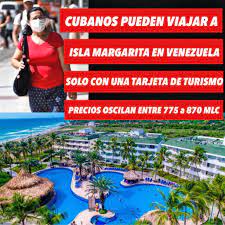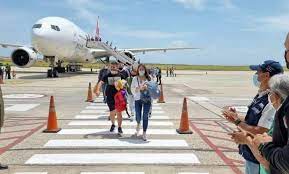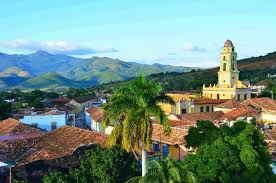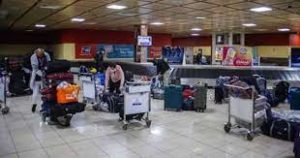AYUDA EN DOLARES DE EMIGRADOS CUBANOS VIAJAN HOY A VENEZUELA CON “LAS MULAS”. PHOTOS.
En Cuba “una mula” ahora también lo es un comerciante furtivo, individual y por la libre, que viaja al extranjero para luego regresar a la Isla con alimentos y mercancías que la economía castrista es incapaz de producir.
Y nos hacemos esta pregunta: ¿Necesitan hoy los ciudadanos de Argentina, Uruguay, o Costa Rica, que miles de “mulas” saquen del país y gasten en el extranjero millones de dólares para poder alimentarse un poquito mejor, vestirse, obtener sus medicinas clave, teléfonos móviles, computadoras, etc?
De esas naciones que en 1958 integraban junto con Cuba la vanguardia de América Latina, con el mayor nivel de vida regional según la ONU, es Cuba la única que 65 años después necesita de “mulas”.
Daniel Ortega, para explicar la avalancha abrumadora de cubanos que estaban volando a Nicaragua para luego jugarse la vida en su recorrido hasta EEUU, aseguraba en serio, no en broma: “Es que vienen a conocer los volcanes de Nicaragua”.
Eso es exactamente lo que dice el régimen venezolano para explicar la avalancha de cubanos que está viajando ahora a ese país: “Vienen a conocer las bellezas naturales, las manifestaciones culturales y la auténtica gastronomía de la isla de Margarita”.
Así lo afirmó sin sonrojarse, hace unos días, la viceministra de Turismo de Venezuela, Leticia Gómez, al informar que a Isla Margarita han arribado casi 5.000 cubanos desde marzo de 2022. En su abrumadora mayoría son “mulas” que gastan como promedio unos 5.000 dólares per cápita en solo cuatro o cinco días, según reconoció el jefe de Leticia, Alí Padrón, ministro chavista de Turismo.
O sea, lo cierto es que se ha disparado el “turismo” cubano en Venezuela. El Gobierno de Caracas solo les pide a los cubanos que compren una tarjeta de turismo venezolano que cuesta solo 30 euros en efectivo, con vigencia de 30 días.
El costo de la tarjeta, que en la práctica equivale a una visa, no está incluido en el precio de los paquetes, que por tres noches cuestan 775 dólares, y 870 dólares una semana, y que incluyen el boleto de ida y vuelta en avión, el alojamiento, el traslado a los hoteles y a un centro comercial para compras, así como “un plan alimenticio” con “desayuno y cena”. Todo a pedir de boca y barato.
Los paquetes de viaje son comercializados por la agencia estatal cubana Cubatur, mientras que la aerolínea venezolana Estelar se encarga del traslado. También se abrió otro destino turístico en Las Piedras, zona franca de Paraguaná, en el estado de Falcón, que es operado por la aerolínea estatal chavista Conviasa.
NEGOCIO PARA LAS DOS DICTADURAS…
Según la viceministra venezolana Leticia Gómez, el 3 de febrero pasado arribaron al Aeropuerto Santiago Mariño de Isla Margarita 48 nuevos visitantes cubanos, que sumaron 4.834 isleños en los últimos 11 meses.
La explicación de todo esto es simple. La escasez de bienes de consumo se ha agravado demasiado en Cuba, y como es tan fácil viajar a Isla Margarita, ser “mula” ha devenido un negocio beneficioso no solo para el viajante en cuestión y los consumidores cubanos, sino también para la cúpula castrista, y para la de Caracas.
Según el Ministerio de Turismo venezolano si cada cubano gasta entre 3.000 y 5.000 dólares, los negocios y mercados de esa zona de Venezuela obtienen hasta 20 millones de dólares al año, una gran cantidad de billetes verdes que mayormente fueron enviados a Cuba por emigrados cubanos como ayuda humanitaria a sus familiares en la Isla.
Y Nicolás Maduro está dando pasos para aumentar el número de “turistas” cubanos a unos 6.000 anuales, que podrían dejar en suelo venezolano más de 30 millones de dólares al año.
Ambas autocracias bendicen la “Operación Muleros”. Por eso previamente el régimen de Castro I suprimió el pago de aranceles en las aduanas cubanas de prácticamente todo lo que puede cargar una “mula” en un avión, como alimentos, medicamentos, productos de aseo, celulares, computadores, tabletas, neumáticos y llantas y equipos electrodomésticos no muy grandes para que sean aceptados en el avión.
Hoy ni con divisas la gente en Cuba puede adquirir esos productos, ni medicinas imprescindibles, pues las shopping están desabastecidas. Son las “mulas” la que abastecen al mercado negro, único que funciona en la Isla. Aunque, por muchas “mulas” que haya, su oferta informal de mercancías al regresar a la Isla está muy lejos de cubrir siquiera el 30% de la demanda nacional, de cualquier cosa que vendan.
EL NEGOCIO DE LAS MULAS DESCAPITALIZA A CUBA…
Y ojo, la otra cara de la moneda aquí es que el negocio de las “mulas” descapitaliza más la ya descapitalizada economía cubana. Genera fuga de capitales, porque salen de Cuba millones de dólares que podrían invertirse en el país.
Claro, no pueden ser invertidos en la Isla por la negativa criminal de Raúl “El Cruel” de restaurar la libre empresa y liberar las fuerzas productivas de la nación para producir de todo en la Isla, y en grande, y que no haya que importarlo, ya sea a través de “mulas” o de los monopolios de GAESA. O sea, la negativa a invertir capital no solo para para abrir tiendecitas, paladares, o precarios talleres de producción artesanal que ya pululaban en tiempos de Carlomagno.
Lo cierto es que con las “mulas” se van divisas de Cuba. Lo razonable sería que esos dólares fuesen invertidos para crear riquezas y ganancias comerciales en suelo cubano, no allende los mares.
Algo que choca mucho es que con este “turismo” cubano en Venezuela se benefician dos tiranías implacables. El castrismo libera presión política al aumentar la entrada de productos que impiden la hambruna y el colapso de la economía. Y el madurismo capta divisas.
Además, a Isla Margarita no solo van furtivos comerciantes privados y cuentapropistas cubanos y gente sencilla y honesta para comprar suministros, sino hijos de papá, amiguetes y testaferros corruptos de los mafiosos millonarios que usurpan el poder en Cuba. Ellos son dueños de pequeños negocios en la Isla y en el extranjero. Viajan a comprar suministros y también a hacer inversiones en boyantes negocios privados suyos lo mismo en Panamá, Guyana, Nicaragua, México, Ecuador, Chile, que en Rusia y otras naciones del Este europeo.
LOS EMIGRADOS CUBANOS FUERA DE CUBA TAMBIEN AYUDAN A EL DICTADOR MADURO…
Como vimos, es la emigración cubana la que de una u otra forma financia todo eso, con dinero que obtienen trabajando duro en el “imperio”, luego de haber sido prácticamente expulsados de Cuba, o compulsados a hacerlo a golpes de comunismo. Son ellos los que aportan mayormente el dinero que las “mulas” gastan fuera de Cuba.
Y no estoy en contra de las “mulas”, ni mucho menos, pues sé que en las actuales circunstancias son necesarias. Y también que la mayoría de ellas no son comerciantes como tales, sino personas que solo reciben un salario, o una comisión de quienes ponen el dinero para realizar el viaje y las compras. Pero como dice una frase española arraigada en Cuba: “las cosas claras y el chocolate espeso”.
Sobresale aquí una colosal ironía. Resulta que hoy la emigración cubana, de carambola, “sin comerla ni beberla”, está financiando involuntariamente también a la tiranía de Nicolás Maduro y sus secuaces. ¡Le zumba el mango!
Finalmente, la conclusión aquí es aún más paradójica, insensible o descorazonadora. Tanto que es mejor expresarla gráficamente con una metáfora: la “mula” es una aspirina, alivia el dolor, pero no cura la enfermedad.
HELP IN DOLLARS FROM CUBAN EMIGRADES TRAVEL TO VENEZUELA TODAY WITH “THE MULES”. PHOTOS.
In Cuba, “a mule” is now also a furtive merchant, individual and for free, who travels abroad to later return to the Island with food and merchandise that the Castro economy is incapable of producing.
And we ask ourselves this question: Do the citizens of Argentina, Uruguay, or Costa Rica today need thousands of “mules” to leave the country and spend millions of dollars abroad to be able to feed themselves a little better, dress, obtain their key medicines? , mobile phones, computers, etc?
Of those nations that in 1958 formed the vanguard of Latin America together with Cuba, with the highest regional standard of living according to the UN, Cuba is the only one that 65 years later needs “mules.”
Daniel Ortega, in order to explain the overwhelming avalanche of Cubans who were flying to Nicaragua and then risking their lives on their way to the US, assured seriously, not jokingly: “It’s that they come to see the volcanoes of Nicaragua.”
That is exactly what the Venezuelan regime says to explain the avalanche of Cubans who are now traveling to that country: “They come to see the natural beauties, the cultural manifestations, and the authentic gastronomy of the island of Margarita.”
This was stated without blushing, a few days ago, by the Vice Minister of Tourism of Venezuela, Leticia Gómez, when reporting that almost 5,000 Cubans have arrived on Isla Margarita since March 2022. The overwhelming majority are “mules” who spend an average of 5,000 dollars per capita in just four or five days, as acknowledged by the head of Leticia, Alí Padrón, Chavista’s Minister of Tourism.
In other words, the truth is that Cuban “tourism” in Venezuela has skyrocketed. The Government of Caracas only asks Cubans to buy a Venezuelan tourist card that costs only 30 euros in cash, valid for 30 days.
The cost of the card, which in practice is equivalent to a visa, is not included in the price of the packages, which cost $775 for three nights and $870 for a week and include a round-trip air ticket. , accommodation, transfer to hotels and a shopping mall, as well as “a meal plan” with “breakfast and dinner”. Everything to order and cheap.
The travel packages are marketed by the Cuban state agency Cubatur, while the Venezuelan airline Estelar is in charge of the transfer. Another tourist destination was also opened in Las Piedras, a free zone of Paraguaná, in the state of Falcón, which is operated by the Chavista state airline Conviasa.
BUSINESS FOR THE TWO DICTATORSHIPS…
According to Venezuelan Vice Minister Leticia Gómez, on February 3, 48 new Cuban visitors arrived at the Santiago Mariño Airport on Isla Margarita, totaling 4,834 islanders in the last 11 months.
The explanation of all this is simple. The shortage of consumer goods has become too serious in Cuba, and since it is so easy to travel to Isla Margarita, being a “mule” has become a profitable business not only for the traveler in question and Cuban consumers but also for the Castro leadership. , and for Caracas.
According to the Venezuelan Ministry of Tourism, if each Cuban spends between 3,000 and 5,000 dollars, businesses and markets in that area of Venezuela obtain up to 20 million dollars a year, a large number of green bills that were mostly sent to Cuba by Cuban emigrants such as humanitarian aid to their relatives on the island.
And Nicolás Maduro is taking steps to increase the number of Cuban “tourists” to about 6,000 a year, who could leave more than 30 million dollars a year on Venezuelan soil.
Both autocracies bless “Operation Muleros.” For this reason, the Castro I regime previously abolished the payment of tariffs at Cuban customs for practically everything that a “mule” can carry on an airplane, such as food, medicines, toiletries, cell phones, computers, tablets, tires and rims. and appliances that are not too large to be accepted on the plane.
Today, even with hard currency, people in Cuba cannot buy these products, nor essential medicines, because the malls are out of supplies. It is the “mules” that supply the black market, the only one that works on the Island. Although, no matter how many “mules” there are, their informal supply of merchandise upon returning to the Island is far from covering even 30% of the national demand, for whatever they sell.
THE MULE BUSINESS DECAPITALIZES CUBA…
And beware, the other side of the coin here is that the “mules” business under-capitalizes the already undercapitalized Cuban economy. It generates capital flight because millions of dollars leave Cuba that could be invested in the country.
Of course, they cannot be invested on the Island due to the criminal refusal of Raúl “El Cruel” to restore free enterprise and free the productive forces of the nation to produce everything on the Island, and in a big way, and not have to import it. , either through “mules” or the GAESA monopolies. In other words, the refusal to invest capital was not only to open little shops, palates, or precarious artisan production workshops that were already teeming in the time of Charlemagne.
The truth is that with the “mules” foreign currency is leaving Cuba. It would be reasonable for those dollars to be invested to create wealth and commercial profits on Cuban soil, not overseas.
Something that is very shocking is that with this Cuban “tourism” in Venezuela two implacable tyrannies benefit. Castroism releases political pressure by increasing the entry of products that prevent famine and the collapse of the economy. And Maduro captures foreign currency.
In addition, not only private merchants and Cuban self-employed furtive and simple and honest people go to Isla Margarita to buy supplies, but also daddy’s sons, friends, and corrupt front men of the millionaire mobsters who usurp power in Cuba. They are owners of small businesses on the Island and abroad. They travel to buy supplies and also to invest in thriving private businesses of their own, the same in Panama, Guyana, Nicaragua, Mexico, Ecuador, and Chile, as well as in Russia and other Eastern European nations.
CUBAN EMIGRATES OUTSIDE CUBA ALSO HELP DICTATOR MADURO…
As we have seen, it is the Cuban emigration that in one way or other finances all this, with money that they obtain working hard in the “empire”, after having been practically expelled from Cuba, or compelled to do so by blows of communism. They are the ones who contribute most of the money that the “mules” spend outside of Cuba.
And I’m not against “mules”, far from it, because I know that in the current circumstances, they are necessary. And also that most of them are not merchants as such, but people who only receive a salary, or a commission from those who put the money to make the trip and purchases. But as a Spanish phrase rooted in Cuba says: “clear things and thick chocolate.”
A colossal irony stands out here. It turns out that today the Cuban emigration, of star fruit, “without eating or drinking it”, is also involuntarily financing the tyranny of Nicolás Maduro and his henchmen. He buzzes the handle!
Finally, the conclusion here is even more paradoxical, insensitive, or heartbreaking. So much so that it is better to express it graphically with a metaphor: the “mule” is an aspirin, it relieves pain, but it does not cure the disease.
Agencies/Wiki/ DDC/ Roberto Alvarez/ Extractos/ Excerpts/ Internet Photos/ Arnoldo Varona/ www.TheCubanHistory.com
THE CUBAN HISTORY, HOLLYWOOD.









